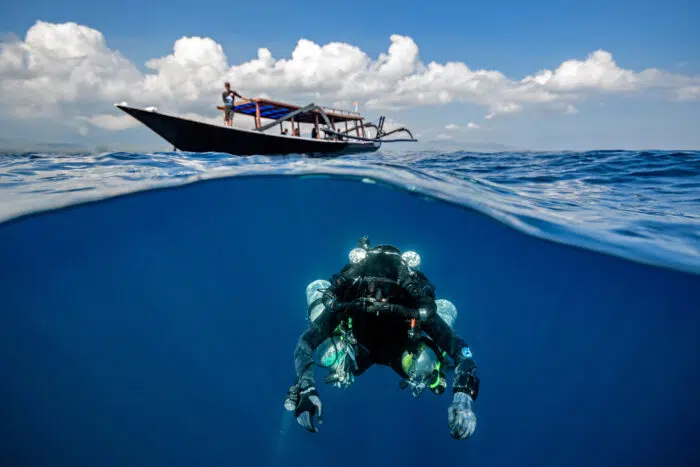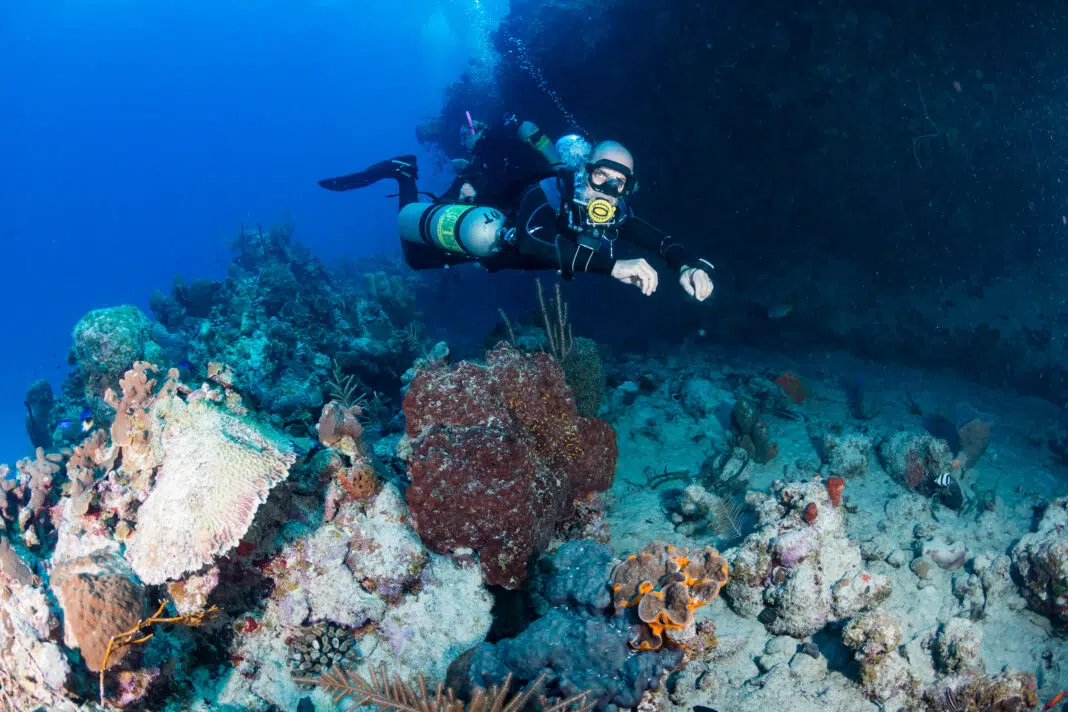If you have ever felt the temptation to stay a little longer or go deeper, then technical diving is probably for you. Technical diving is about pushing the limits; if you see something a little deeper than your planned depth, you can come back and do a technical dive to fully explore what you have seen.
Ultimately, technical diving is about exploration and pushing our limits underwater. It allows us to go to new places and experience things we have not seen before.

What is Technical Diving?
Technical diving is defined as diving beyond recreational diving limits. Cast your mind back to your open water course and using a dive table. Typically, a dive to 18m/60ft had a no-decompression limit of around 56 minutes—there are some minute variances depending on the model used to make the table. So what happens if you want to spend 70 minutes at 18m/60ft? It is possible, but you are now outside the realm of technical diving.
At the other end of the table, you can only find information for divers up to a depth of around 40m/130ft. What happens if you want to dive to 55m/180ft. Can it be done? Of course, it can and is done every day worldwide; however, you are now in the realm of technical diving since you are diving beyond the range of recreational diving.
Generally speaking, when you do a technical dive, you enter an overhead environment, whether real or virtual. Once you have exceeded your decompression limits through time or depth, you have lost safe, direct access to the surface due to your decompression obligations. Even if you are in a real overhead environment, you have also lost direct access to the surface since you must return to a suitable access point to safely reach the surface.
Technical Diving Equipment and Configuration
Technical diving equipment and configurations primarily deal with redundancy and how to complete a dive safely. Whenever possible, divers will have two of an item in case there is a failure with a piece of equipment underwater. Most glaringly, divers use a twinset or a set of doubles to carry their bottom gas. Over the last decades, more divers have started using two independent side mount cylinders.
Having two cylinders makes dealing with regulator and tank failures much easier while maintaining an adequate gas supply. In addition, divers will often carry multiple masks, reels, and other critical items.
Regarding configuration, technical diving generally uses what is referred to as a Hogarthian rig. Named after technical diving pioneer Charles William Hogarth. The rig uses a long regulator hose, a short regulator hose bunged around the diver’s neck, and one tank SPG on the diver’s left. The configuration reduces failure points while providing the diver with critical safety information.
It also aims to ensure that the out-of-air diver receives a regulator second stage that works and supplies a mix of gas appropriate for the depth in an emergency. That is why technical divers are trained to donate the regulator they are breathing from and not let the out-of-air divers choose from a bunch of regulators hanging in their chest area.
Technical Diving Skills and Training
The main issue with technical diving is that you must complete your dive plan to surface safely. Most technical training and skills address this, whether completing your plan means reaching a specific point in an overhead environment or completing your decompression. As such, technical training deals with three broad areas.
Equipment failure
What happens when a piece of equipment fails? Consider that when you are technical diving, there is no non-safety critical gear; every piece of kit is safety critical. Training covers redundancy – why tec divers use doubles instead of single cylinders. As well as what to do in an emergency. For instance, how do you deal with a regulator’s first-stage failure on your doubles? Or a wing failure, or even what to do in the highly unlikely event you lose your mask.
Each of these cases has a set of procedures to implement, meaning you can abort the dive, still complete your accrued decompression, and safely reach your exit.
Gas management & planning
Another significant aspect of technical training is gas management & planning, not in terms of which gases to breathe – more about that in the next section. But in the volumes involved. You learn to work out how much of every type of gas you will need for every dive.
The training also includes contingency planning, covering lost gas scenarios, and ensuring you have sufficient alternative gas volumes to complete your adjusted decompression obligations or reach the exit of your dive.

Decompression Planning
Finally, technical diving involves learning how to plan decompression dives. Divers learn how to use air and nitrox to decompress. They also learn how the different gases affect their decompression schedule and how to use Nitrox to accelerate their decompression.
More advanced courses aimed at taking divers even deeper introduce Helium into the mix. Here, divers learn how to use Trimix (Helium, Oxygen, and Nitrogen) to dive to greater depths and what considerations they must make when using helium. Once Helium is introduced, you learn about planning, Isobaric counter diffusion, HPNS, and many more varied and exciting niche aspects of decompression diving.
Top Technical Dive Sites
The list of top technical diving sites is virtually endless; almost every dive site worldwide can be dived as a technical dive. However, some dive sites are famous or infamous and known worldwide as technical diving sites. These are primarily due to their depth.
With its renowned arch, the Blue Hole in Dahab, Egypt, is probably one of the world’s most infamous technical dive sites. It is also a mecca for freedivers due to the incredible depth that can be achieved from shore. Whether diving the arch at 55m/180ft or heading to the bottom at 100m/330ft – this slopes out, and you can dive to an excess of 200m/660ft there.
Another blue hole, this time Dean’s blue hole, is located off Long Island in the Bahamas. It is another world-renowned technical diving site. Although it is deeper than the blue hole in Egypt, with a depth of 202 m/667 ft, it is not as infamous since there have been nowhere near the same number of fatalities.
Some of the best technical diving sites are wreck dives that lie beyond recreational limits; many date from WWII. These include some of the deeper wrecks at Truk and Chuuk Lagoon in Micronesia and some of the wrecks in Scapa Flow. Technical diving U-boat fans can also experience the graveyard of the Atlantic off the coast of the Carolinas, not to mention Operation Deadlight off the west coast of Ireland, where many U-boats were sunk at the war’s end.
The list of excellent technical diving sites is virtually endless. However, all the sites have one thing in common. Divers choose to dive to see something and explore, not to pursue depth for the sake of depth.
Technical Diving Safety and Planning
Technical dive planning is almost entirely safety-focused. Many things can go wrong, and the possible results are catastrophic. Many aspects of technical diving planning revolve around risk management and mitigation to improve safety.
One aspect is gas planning. For instance, it becomes almost impossible for a diver to carry sufficient redundant decompression gas to manage a catastrophic gas loss situation on deeper dives. Depending on the location and gas volumes involved, the team may opt to have a shared redundant gas scenario, where the team as a whole carries enough reserves for one or two gas loss situations.
Alternatively, the team may use safety/support divers if logistics allow. Who can respond to an emergency signal and descend with more needed gas supplies?
The bigger (deeper/longer) the dive and the bigger the team, the more complex the picture becomes. You have situations where the support divers require support divers since they are undertaking big dives in support of the main dive. The required number of cylinders with various mixes can often run into hundreds.
Obviously, there are many other factors to consider when planning technical dives, including the emergency evacuation protocols, where the nearest chamber is, and whether it is on standby, sufficient surface Oxygen for dealing with more than one diver, and the entire team being onboard with the plan and happy to go ahead. Most bigger technical diving projects are like major expeditions, requiring substantial logistics and planning to work seamlessly.

